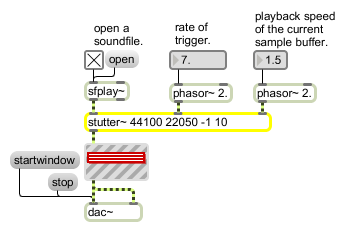Examples

stutter~ captures a new slice of incoming sound into an oscillating buffer whenever it receives a trigger
Signal capture and granular oscillator
| Name | Type | Opt | Description |
|---|---|---|---|
| maximum-buffer-length (samples) | int | Obligatory. The maximum buffer length, in samples. This determines the memory size of the record buffer. Parts of the record buffer are copied to the playback buffer when the object is triggered. | |
| initial-buffer-size (samples) | int | Obligatory. The initial buffer size, in samples, to copy from the record to the playback buffer upon receiving a trigger. | |
| trigger-polarity | int | Obligatory. The polarity to use for accepting a trigger signal in the middle inlet. If the argument is greater than 0, stutter~ accepts a positive trigger; otherwise stutter~ accepts a negative trigger. | |
| number-of-copied-samples (samples) | int | Obligatory. The number of samples which are copied from the record buffer to the playback buffer each iteration of the perform loop (the signal vector size). A larger value will decrease the stutter~ object's memory requirements and increase the CPU requirements. | |
| number-of-outputs | int | opt | An optional fifth argument allows you to specify multiple independent signal outputs the stutter~ object will use when playing back from the playback buffer. The default is 1, and the maximum is 30. The number of phase signal inputs to the stutter~ object is also determined by this argument. |
| bang | In left inlet: A causes the last buffer of recorded samples to be copied to the playback buffer. You can use a instead of or in conjunction with the middle inlet trigger signal. | |
| int | size-of-playback-buffer (samples) [int] |
In left inlet: Specifies the size (in samples) of the playback buffer. This can be any number up to the maximum memory determined by the first argument to stutter~. |
| ampvar | random-amplitude-variation [float] |
The word , followed by a float, specifies a random amplitude variation in the output signal(s). The default is 0 (no variation). |
| clear | Clears the object's sample memory. | |
| dropout | drop-out-chance [float] |
The word , followed by a float, determines the percentage chance of a playback signal dropping out (i.e. 'gapping' or not playing). The default is 0 (no gapping). |
| maxsize | maximum-buffer-size (samples) [int] |
The word , followed by a number, sets the maximum buffer size, in samples. |
| polarity | trigger-polarity (0 or 1) [int] |
The word , followed by a zero or one, changes the trigger polarity of stutter~ to negative or positive, respectively. |
| The word will cause the object to print a detailed listing of all of its parameter settings within the Max window. | ||
| repeat | repeat-chance [float] |
The word , followed by a float, determines the percentage change of the record buffer not being copied to the playback buffer so that the previous playback buffer is repeated. The default is 0 (no repeat). |
| setbuf |
buffer-name [symbol] sample-offset [int] channel-number [int] |
The word , followed by arguments for a buffer name, a sample offset, and a channel, copies the specified samples to the named buffer~ object. Note: stutter~ always uses its internal buffer as the playback buffer; the copied samples can be sent to a named buffer~ object for use in some other way, if desired. The time required to move the specified amount of memory to the buffer is n/m, there n is the number of samples being copied and m is the fourth argument to the stutter~ object. |
| signal | In left inlet: Signals coming into the left inlet are stored in a record buffer, where they can be copied into a playback buffer and used as a playback source. In middle inlet: Accepts a trigger signal, which can be specified to be positive or negative. When the signal changes polarity in the correct direction, samples recorded from the left inlet are copied to the playback buffer. In right and successive inlets: A phase signal input in the range of 0-1 for each inlet controls the output speed of the playback buffer for that inlet. The number of phase inlets in a stutter~ object is set using the fifth argument; the default is a single inlet. Specifying multiple phase inlets allows you to specify multiple playback points in the sampled buffer. |
